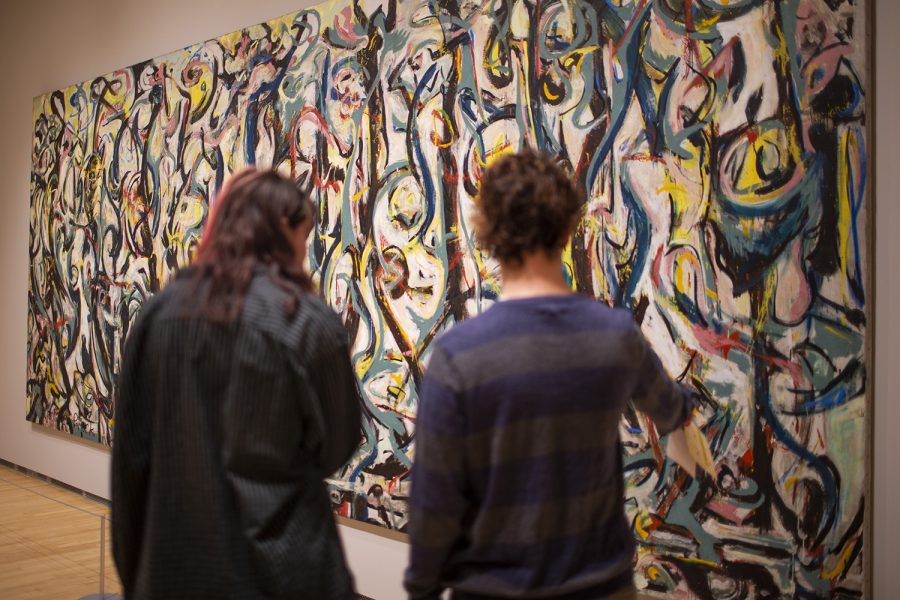Opinion | “Mural” is worth more than dollars
Artist Jackson Pollock, “Mural,” is appraised for $140 million. Should the UI sell the famous painting?
Eva Olson and Aidan Bolden point at the Jackson Pollock mural in the Stanley Museum of Art on Sunday, Sept. 11, 2022. This was Olson and Bolden’s first time walking through the museum.
September 11, 2022
Hanging in the Stanley Museum of Art at the University of Iowa is a massive 8-by-20-foot oil canvas, “Mural,” by the late artist, Jackson Pollock.
When I saw Pollock’s painting, I was underwhelmed. While the painting is impressive in size, little else about it seemed notable. Arbitrary movements of lemon yellow, red, teal, and umber melt into each other, forming no clear objects or scenes.
“Mural” has been appraised at $140 million. The debate over whether Pollock’s painting should stay at the UI or be sold has raged for several years. To some, selling “Mural” is an opportunity to support art elsewhere. But to others, “Mural” is worth more than dollars.
Paul Jackson Pollock was born in Cody, Wyoming in 1912. Pollock spent his early life studying art under artists Frederick John Vrain Schwankovsky and Thomas Hart Benton. Pollock is remembered as an influential figure in the abstract expressionist movement, notably known for his “drip technique.”
In 1943, American socialite and art collector Peggy Guggenheim commissioned Pollock to create a mural for her townhouse. This commission is the now known “Mural.”
Guggenheim donated the “Mural” to UI in 1951. The UI loaned the painting to museums around the world, attracting more than 2.5 million visitors. After a two-year restoration and technical study, the painting is now back in Iowa City.
“Mural” is no stranger to negative public attention. For years, people believe Pollock painted “Mural” in one frenzied night after staring at the blank canvas for months. It was not until recently that experts debunked this myth, citing the painting was made over a series of months.
In Iowa, “Mural” has been a topic of financial debate for years.
In 2011, former Chairman of the House of Appropriations Committee, Rep. Scott Raecker, proposed a bill to sell the painting.
House Study Bill 84 proposed, “The state Board of Regents shall provide for the sale of the Jackson Pollock painting, “Mural,” as held by the state University of Iowa.”
The bill proposed that royalties of the sale be credited to a trust fund for providing scholarship assistance to undergraduate students majoring in art at the UI.
While this bill was shut down, many in Iowa were worried about the future of the Pollock painting.
Artist and former UI student, Deborah Stein, said the “Mural” belongs on the UI campus.
“I think the painting needs to be here as a tool to show art students what art looks like,” Stein said. “What an artist who is completely passionate can create. This is much more than monetary value.”
When visiting the Stanley Museum of Art, I spent time with “Mural” to try and better understand the value of the painting. It did resonate with me.
“I don’t think it symbolizes anything.” Stein said. “I don’t think that’s what Pollock’s artwork was about. It was a move for self-expression.”
“What was the question before this art and what was the curiosity that made them want to continue.” Stein said. “It’s different for every artist. Not all art, like not all poetry or literature is one thing. It’s everyone coming from a different place and putting themselves into it. That’s what makes this piece so powerful.”
Despite my feelings surrounding “Mural,” I am proud to have this work of art on the UI campus. “Mural” is more than a canvas — it’s a movement. Pollock’s painting shows what art is, in life and on canvas.
The UI should keep “Mural” on campus for future generations. Pollock’s work is more valuable than its price tag.
Columns reflect the opinions of the authors and are not necessarily those of the Editorial Board, The Daily Iowan, or other organizations in which the author may be involved.















